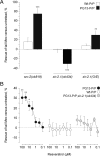Neuron dysfunction is induced by prion protein with an insertional mutation via a Fyn kinase and reversed by sirtuin activation in Caenorhabditis elegans
- PMID: 20392961
- PMCID: PMC6632766
- DOI: 10.1523/JNEUROSCI.5831-09.2010
Neuron dysfunction is induced by prion protein with an insertional mutation via a Fyn kinase and reversed by sirtuin activation in Caenorhabditis elegans
Abstract
Although prion propagation is well understood, the signaling pathways activated by neurotoxic forms of prion protein (PrP) and those able to mitigate pathological phenotypes remain largely unknown. Here, we identify src-2, a Fyn-related kinase, as a gene required for human PrP with an insertional mutation to be neurotoxic in Caenorhabditis elegans, and the longevity modulator sir-2.1/SIRT1, a sirtuin deacetylase, as a modifier of prion neurotoxicity. The expression of octarepeat-expanded PrP in C. elegans mechanosensory neurons led to a progressive loss of response to touch without causing cell death, whereas wild-type PrP expression did not alter behavior. Transgenic PrP molecules showed expression at the plasma membrane, with protein clusters, partial resistance to proteinase K (PK), and protein insolubility detected for mutant PrP. Loss of function (LOF) of src-2 greatly reduced mutant PrP neurotoxicity without reducing PK-resistant PrP levels. Increased sir-2.1 dosage reversed mutant PrP neurotoxicity, whereas sir-2.1 LOF showed aggravation, and these effects did not alter PK-resistant PrP. Resveratrol, a polyphenol known to act through sirtuins for neuroprotection, reversed mutant PrP neurotoxicity in a sir-2.1-dependent manner. Additionally, resveratrol reversed cell death caused by mutant PrP in cerebellar granule neurons from prnp-null mice. These results suggest that Fyn mediates mutant PrP neurotoxicity in addition to its role in cellular PrP signaling and reveal that sirtuin activation mitigates these neurotoxic effects. Sirtuin activators may thus have therapeutic potential to protect from prion neurotoxicity and its effects on intracellular signaling.
Figures





Similar articles
-
Resveratrol rescues mutant polyglutamine cytotoxicity in nematode and mammalian neurons.Nat Genet. 2005 Apr;37(4):349-50. doi: 10.1038/ng1534. Epub 2005 Mar 27. Nat Genet. 2005. PMID: 15793589
-
Cross-talk between canonical Wnt signaling and the sirtuin-FoxO longevity pathway to protect against muscular pathology induced by mutant PABPN1 expression in C. elegans.Neurobiol Dis. 2010 Jun;38(3):425-33. doi: 10.1016/j.nbd.2010.03.002. Epub 2010 Mar 19. Neurobiol Dis. 2010. PMID: 20227501
-
SIRT1, a histone deacetylase, regulates prion protein-induced neuronal cell death.Neurobiol Aging. 2012 Jun;33(6):1110-20. doi: 10.1016/j.neurobiolaging.2010.09.019. Epub 2010 Nov 12. Neurobiol Aging. 2012. PMID: 21074897
-
Prion neurotoxicity: insights from prion protein mutants.Curr Issues Mol Biol. 2010;12(2):51-61. Epub 2009 Sep 18. Curr Issues Mol Biol. 2010. PMID: 19767650 Free PMC article. Review.
-
The prion gene complex encoding PrP(C) and Doppel: insights from mutational analysis.Gene. 2001 Sep 5;275(1):1-18. doi: 10.1016/s0378-1119(01)00627-8. Gene. 2001. PMID: 11574147 Review.
Cited by
-
Sirt1: def-eating senescence?Cell Cycle. 2012 Nov 15;11(22):4135-46. doi: 10.4161/cc.22074. Epub 2012 Sep 14. Cell Cycle. 2012. PMID: 22983125 Free PMC article. Review.
-
Caenorhabditis elegans dnj-14, the orthologue of the DNAJC5 gene mutated in adult onset neuronal ceroid lipofuscinosis, provides a new platform for neuroprotective drug screening and identifies a SIR-2.1-independent action of resveratrol.Hum Mol Genet. 2014 Nov 15;23(22):5916-27. doi: 10.1093/hmg/ddu316. Epub 2014 Jun 19. Hum Mol Genet. 2014. PMID: 24947438 Free PMC article.
-
Metabotropic glutamate receptor 5 is a coreceptor for Alzheimer aβ oligomer bound to cellular prion protein.Neuron. 2013 Sep 4;79(5):887-902. doi: 10.1016/j.neuron.2013.06.036. Neuron. 2013. PMID: 24012003 Free PMC article.
-
Prion degradation pathways: Potential for therapeutic intervention.Mol Cell Neurosci. 2015 May;66(Pt A):12-20. doi: 10.1016/j.mcn.2014.12.009. Epub 2015 Jan 10. Mol Cell Neurosci. 2015. PMID: 25584786 Free PMC article. Review.
-
Could Sirtuin Activities Modify ALS Onset and Progression?Cell Mol Neurobiol. 2017 Oct;37(7):1147-1160. doi: 10.1007/s10571-016-0452-2. Epub 2016 Dec 10. Cell Mol Neurobiol. 2017. PMID: 27942908 Free PMC article. Review.
References
-
- Aguzzi A, Sigurdson C, Heikenwaelder M. Molecular mechanisms of prion pathogenesis. Annu Rev Pathol. 2008a;3:11–40. - PubMed
-
- Aguzzi A, Baumann F, Bremer J. The prion's elusive reason for being. Annu Rev Neurosci. 2008b;31:439–477. - PubMed
-
- Araki T, Sasaki Y, Milbrandt J. Increased nuclear NAD biosynthesis and SIRT1 activation prevent axonal degeneration. Science. 2004;305:1010–1013. - PubMed
-
- Bolton DC, McKinley MP, Prusiner SB. Molecular characteristics of the major scrapie prion protein. Biochemistry. 1984;23:5898–5906. - PubMed
Publication types
MeSH terms
Substances
LinkOut - more resources
Full Text Sources
Other Literature Sources
Research Materials
Miscellaneous
